PAGE 1 | PAGE 2 | PAGE 3 | PAGE 4 | PAGE 5 | PAGE 6 | PAGE 7
March 12, 2012

There’s no doubting that Photoshop has changed photography.
I was visiting a pond where a lot of Black Swans hang out, and a couple of birds started posturing at each other (above). With all that splashing and action going on, I of course took some snaps. But the background is kind of ugly, right?
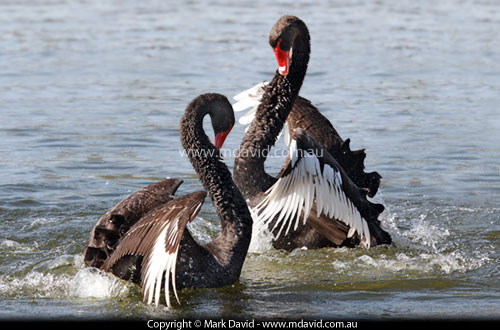
Now the thing about Photoshop is that it makes it just so easy to clean up things like messy backgrounds. Want to delete a bit of wall and part of a swan? No problem. Consider it done (above).
But is this right?
I mean it’s still a photo depicting what happened. I’m not lying, much.
In some ways I think it’s just fine to do this kind of work, providing that it’s in the right circumstances. For example, a lot of photography competitions don’t allow this kind of image manipulation and so I would not enter this image into one of those competitions. And if it appeared somewhere else, then I would simply declare that the image had been manipulated, like I’m doing now.
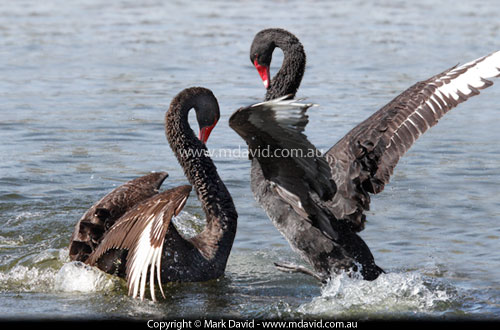
But what about this one (above)? This time, I’ve combined bits from two different photos. I’m still not really lying (much) because it is still a depiction of the two swans posturing on a pond, right? And that happened. So it’s sort of telling the truth.
In this case I think the image is fine to be used in an editorial piece so long as it appears with some kind of explanation somewhere stating that the image has been heavily manipulated. As long as you, the reader, is kept informed honestly then you can make up your own mind about this kind of thing.
In some cases, it’s probably okay to not be too fussy about declaring everything. And in other cases it is extremely important to declare everything. This is the kind of issue facing picture editors every working day.
March 12, 2012
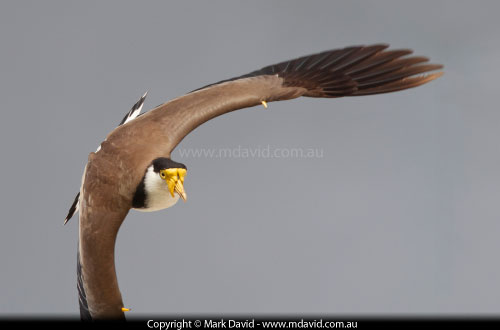
Here’s another swooping Masked Lapwing (Spur-winged Plover). Actually, there’s a 50% chance it’s the same bird as in the previous swooping shot but who’s going to worry about something like that? So how did I get this shot?
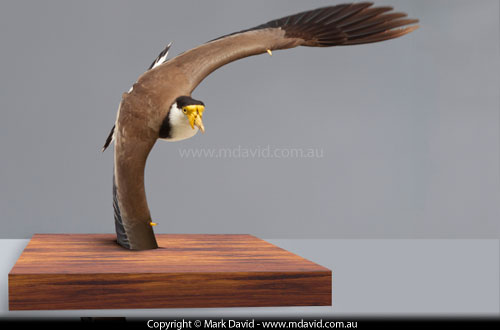
Here’s how I didn’t do it, although I’ll admit that this would have made the job as photographer easier. (Eagle-eyed readers will have already have noticed how I manufactured this image in Photoshop.)
Nope, the truth is I set the camera to shutter speed priority at 1,000th second and used servo focus. And I used a 400mm lens too, to get in close to the action.
It’s not all that easy to track a fast-moving bird through a 400mm lens, so to improve my skills I practise by taking photos of dogs running in the park.
March 11, 2012

Here’s one of the Masked Lapwing (Spur-winged Plover) chicks photographed one day after hatching. Over the next couple of weeks its legs are going to get a lot longer, allowing it run fast. After about 6 weeks it will be fledging and beginning its first brief flights.
March 10, 2012
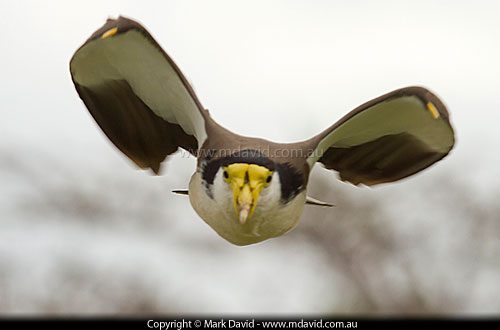
This is either the parent Masked Lapwing from the previous photo, or its mate. And this is how it looks when it’s flying straight at you at speeds approaching warp nine. These birds are relentless, courageous birds when it comes to swooping at people or dogs or whatever when defending their eggs or young. In this case, the birds had built a nest on our lawn and so this is the sight I saw every time I stepped outside the house.
On these occasions I didn’t hang around for long because I would think these swooping raids would be kind of stressful for the bird. Oh yeah, and they were not too relaxing for me either.
March 9, 2012

With Masked Lapwing (Spur-winged Plover) breeding season over I can sort through some of my favourite pics at last. I’ve had this one on my website for a while but thought I’d post it here too. There are four birds in this shot. Strange but true. Hint: one of the birds hasn’t hatched yet.
March 8, 2012
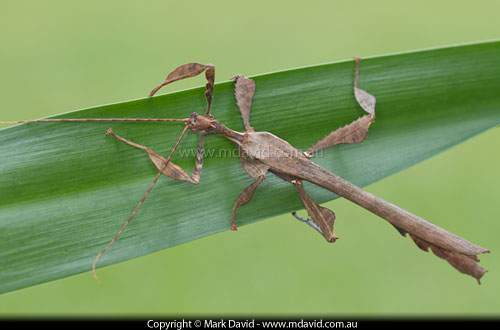
I was pretty happy to find this leaf insect. Leaf insects are closely related to stick insects. There is something funky and appealing about these guys, providing of course that you can find them. Their camouflage when they are hanging around in foliage is so good it’s uncanny.
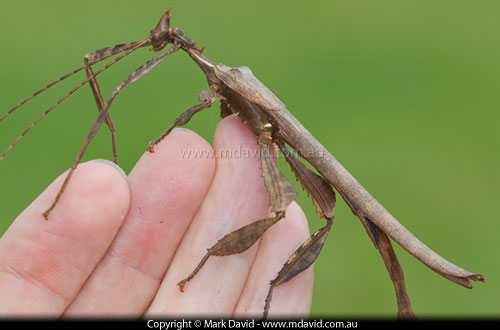
This pic (above) will give you an idea of its size.
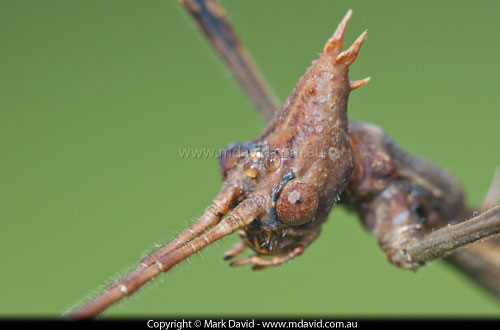
And here’s (above) a close up of its head.
March 5, 2012
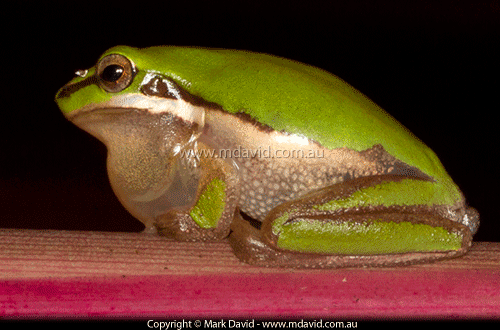
Here’s another one of those Eastern Dwarf Tree Frogs before and after croaking. The little guy was making quite a racket and you can see why. A whole bunch of air is going backwards and forwards between its belly and its throat and along the way it hits something that makes all the noise. I remember the old phrase to ‘put your back into it’ if you are doing some hard physical work. I can say, with genuine admiration, that it looks to me like this frog is putting its back into it.
March 3, 2012
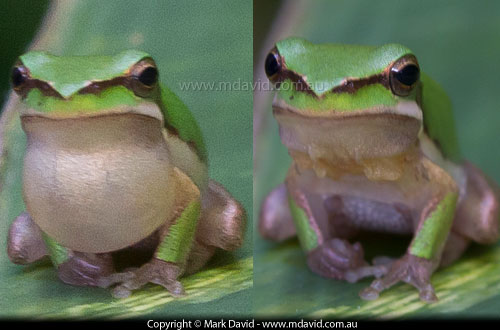
This little guy is an Eastern Dwarf Tree Frog. He may be little (less than an inch long) but what he lacks in size he makes up for in green. Here we see him during and after a croak. And have a look at that loose skin under his chin after the air came out of it. I guess it’s a good thing this frog doesn’t live in Los Angeles then or it would be checking into a clinic for one of those skin tuck operations.
Even though one frog croaked, no animals were harmed while taking this photo.
April 22, 2012
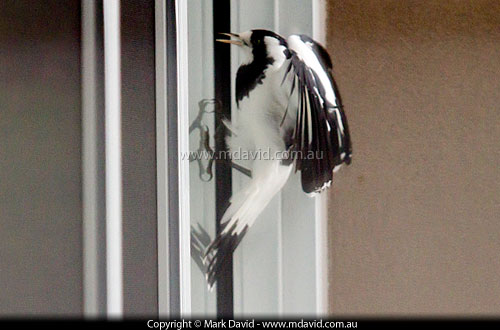
The exact moment that a bird flies into a window. You might think this is due to me being a really smart photographer (why, thanks!) but I’m thinking it might be more this not being a very smart bird. The bird, an Australian Magpie Lark, flies into the same window several times a day. Every day. Usually about 6 times in row before it loses interest. At first I was thinking it must be attacking its own reflection, but it does the same thing to the fly screen over one of our next door neighbours’ windows. And fly screens don’t cast reflections. There are never any bugs on the glass either. No, I just think this bird seems to like flying into windows.
February 25, 2012
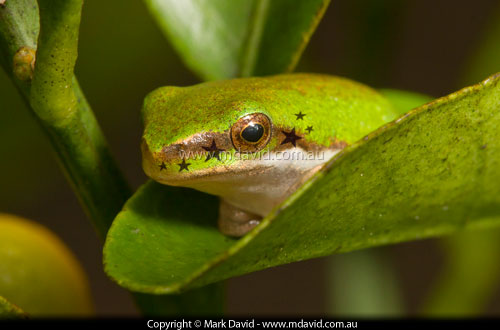
Boy, things have changed. When I was a kid, tattoos were things you only saw on bikers and prison inmates. (No frogs were harmed in the Photoshop manipulation of this picture)
February 23, 2012
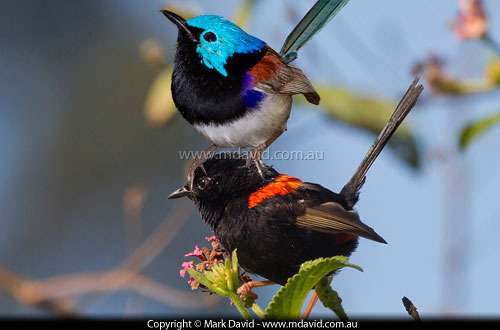
This time it’s a bit of wishful thinking.
Lately I’ve been on a bit of a mission to get a clear shot of some fairy-wrens in their breeding plumage.
I guess you could say that fairy-wrens are to photography what 3 inches of rain in an hour is to getting a suntan. They don’t just make it difficult — they make it difficult in awkward surroundings. You see, experts agree that photography is easier if the subject is big and sitting still in the light. The thing about fairy-wrens is that they are tiny and always moving. And they do their moving mainly in thick foliage — some sort of survival thing, as though not being eaten by cats was somehow more important than posing for my photos. If I had a dollar for every time I’ve huddled in Lantana being bitten by ants while these guys manage to be anywhere except where my lens is pointing then I’d be doing very nicely indeed thank you.
So all that time sitting in Lantana gives you time to dream. Here’s the dream shot, thanks to two visits to the Lantana, about 10 ant bites and some Photoshop.
February 22, 2012

I’ve been taking shots of lightning lately. Always good fun. But the most important thing is to make sure you get the shot rather than the lightning getting you.

Another lightning pic (above). Seriously people, you need to make sure you are in a place that can not be struck by lightning while you are photographing it.
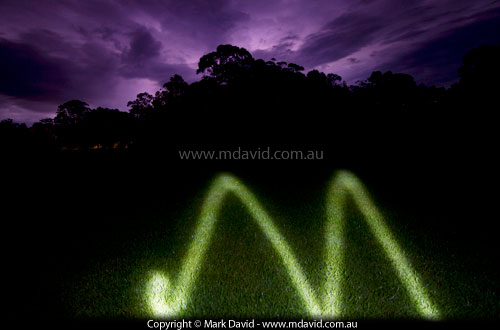
Okay, this time I’m just having some fun (above). To get the lightning pics I was using long exposures. But this time I ‘signed’ my initial in the grass using the torch light while the shutter was open. The camera records it as a light trail.
February 20, 2012
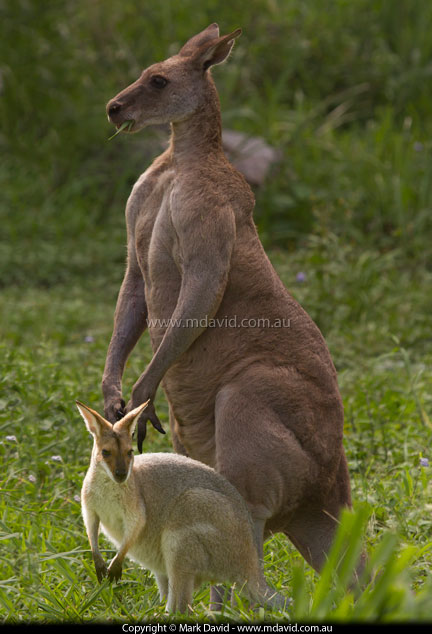
Big bucks, small bucks. This digitally manipulated image shows a pretty accurate comparison in the size of two common marsupials in South Eastern Queensland. That big fella is a mature male Eastern Grey Kangaroo. The little one is a Pretty-faced Wallaby. Both these creatures often share the same paddocks.
February 18, 2012
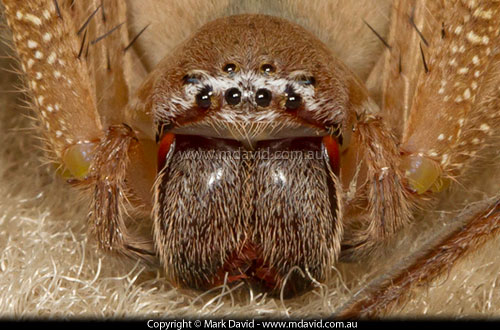
Here’s something you don’t want to see if you’re a bug. It’s a bug’s eye view of a Huntsman Spider standing on the carpet.
I’m not seeing many Huntsmans lately, and I guess the bugs aren’t either. Apparently, the introduced Asian House Gecko (below) is a bit too efficient at catching and eating everything small, including the tiny newly-hatched baby Huntsman spiders.

And since the baby Huntsmans aren’t surviving, the giant wasps that feed the mature Huntsmans to their young are not appearing in the numbers I used to see.
Funny how one critter (a gecko) can affect what seems like a totally unrelated one (the wasp).
February 10, 2012
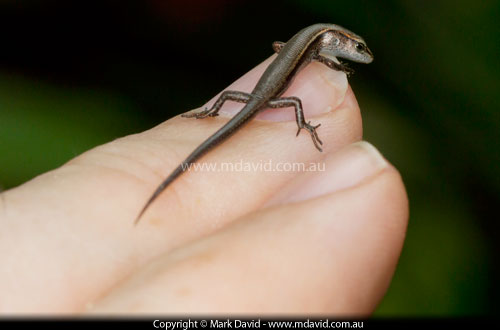
I spotted this young skink recently. Seriously, what’s not to love about a reptile small enough to fit on a fingernail? This wasn’t the easiest photo to take. Skinks don’t stay still for long and of course my other hand was holding the camera.